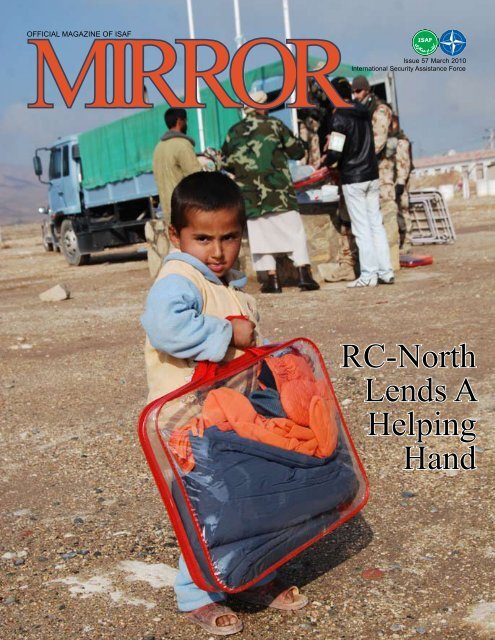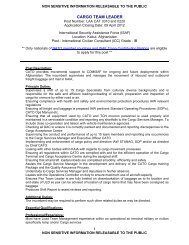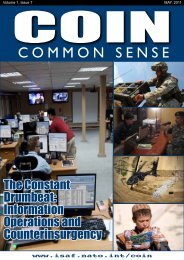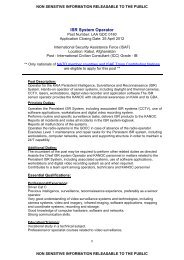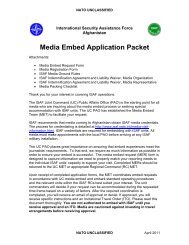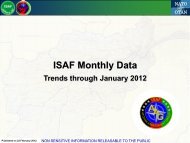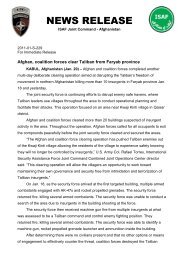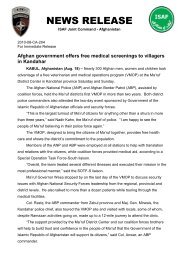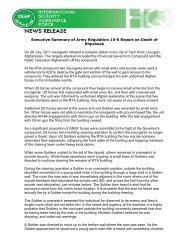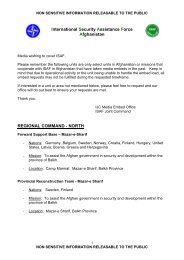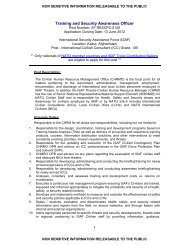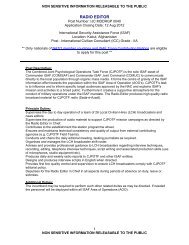Mar. 2010 - Isaf - Nato
Mar. 2010 - Isaf - Nato
Mar. 2010 - Isaf - Nato
- No tags were found...
You also want an ePaper? Increase the reach of your titles
YUMPU automatically turns print PDFs into web optimized ePapers that Google loves.
OFFICIALMIRRORMAGAZINE OF ISAFIssue 57 <strong>Mar</strong>ch <strong>2010</strong>International Security Assistance ForceRC-NorthLends AHelpingHand
Issue 57 <strong>Mar</strong>ch <strong>2010</strong>International Security Assistance ForceMa r c h <strong>2010</strong>Ta b l e o f Co n t e n t s4 Focus on RC-North8 Afghan Children Visit Kandahar9 ANA Air Corps Takes Aim10 Mine Awareness12 Farah PRT Escorts Governor13 Afghan Commandos14 Salang Avalanche Rescue16 Public Education Center17 Afghan Women’s Business Federation18 A Look Around AfghanistanNorwegian soldiers on a patrol in Faryab Province, Afghanistan.The International Security Assistance Force (ISAF) is a NATO-led,43-nation military coalition dedicated to helping Afghan authoritiesprovide security and stability and create the conditions for reconstructionand development. (Photo by ISAF Public Affairs)ISAF ONLINE:Web site: http://www.isaf.nato.intFacebook: http://www.facebook.com/isafTwitter: http://twitter.com/isafmediaYouTube: http://www.youtube.com/isafmediaFlickr: http://www.flickr.com/photos/isafmediaSubmit your photos for possible inclusion in thenext update of the ISAF Mirror. Please send in any highresolution pics that you have taken along with all availableinformation, and we will try to include them in our nextupdate. Please submit your photos to :ijc.mppat@swa.army.milAll editions can be found on the ISAF Web site.MIRROROFFICIAL MAGAZINE OF ISAFRC-NorthLends AHelpingHandOn the cover: An Afghan boyholds on to supplies passed outby Hungarian forces. Membersof the International SecurityAssistance Force distributedwinter supplies to more than200 local Afghan families inBaghlan Province. (Photo byISAF Public Affairs)Editorial Staff:Jane CampbellU.S. Navy CaptainChief, IJC Public AffairsNicholas SabulaU.S. Air Force MajorChief, Multi-Purpose Public Affairs TeamMegan ShutkaU.S. Navy LieutenantSenior EditorCraig StrawserU.S. Navy Chief Petty OfficerEditor, Layout and DesignVincent MouzonU.S. Air Force Technical SergeantEditor, Graphics LayoutThe ISAF Mirror is an International SecurityAssistance Force, Joint Command Public Affairsproduct intended for the information andentertainment of ISAF and associated personnel.Though articles have been edited, opinions expressedare those of the author and do not necessarilyreflect the policies of NATO, Joint ForcesCommand Headquarters, Brunssum or ISAF.The ISAF Mirror is published every month anddistributed among regional commands. Viewit online at www.isaf.nato.int. Submissions toISAF Mirror should be related to ISAF operations;however, other articles may be run based ontheir appeal to an international military audience.Articles should be sent in Microsoft Word formatand photos should be at least 17 cm at 300 dpiresolution. E-mail submissions to ijc.mppat@swa.army.mil. The deadline for submissions isthe 15th day of the month prior to publication.To contact the editor, call DSN 318-449-9151.
Focus on RC- NorthBy RC-North Public AffairsNorthern Afghanistan has nineprovinces (Badakhshan, Takhar,Baghlan, Kunduz, Samangan,Balkh, Sar-i-Pul, Jowzjan andFaryab) with a population of approximately10.8 million.The main population centersare Mazar-e Sharif (app.330,000 inhab.), Kunduz (app.172,000), Taloqan (app. 69,000),Pol-e Khumri (60,000), Faizabad(44,000), Aybak (55,000), Sheberghan(60,000) and Maymana(83,000).Others live in 30,000 small villages(app. 300 people/village)spread across the region.Nevertheless, urbanization inAfghanistan is very low -- 76 percentof the Afghansare living in ruralareas, and in theprovinces of Takharund Badakhshanthat number growsto even more than90 percent.Dari and Pashtoare the main languagesin NorthernAfghanistan. Themain ethnic groupsin Northern Afghanistanare Tajik,Pashtu, Hazara andUzbek. In some regionsthere are alsominorities like Turkmen and Arabs.Afghanistan’s ethnic mosaichas no exact boundaries; nor is itsnational culture uniform. Manyzones overlap and interactionsbroadened as the economic infrastructureimproved and educationalopportunities widened.Local conflicts in all areas, withinall groups, most often erupt overdisputes concerning property or accessto resources; whether it is land,water, money, business or governmentopportunities, bride wealth orinheritance.Rivalries within and betweentribal segments and between tribesand sub-tribes consequently havealways existed. Nonetheless, whenoutside forces threaten, the Pashtuare reputed for their ability toforge formidable alliances, amongthemselves and with other ethnicgroups.Both internal as well as intergroupconflicts are most often rootedin matters of personal and grouphonor, personal enmities, familydissensions concerning brides andproperty, struggles for materialpossession, access to resources,territorial integrity and extensionsof power, rather than in intrinsicattitudes of ethnic discrimination.Because in most areas of NorthAfghanistan, the Afghan governmentis perceived as providinglittle benefit to thepeople, most importantpower structureswill be foundin the ethnic groupsas well as familiesand individual localnetworks.The Afghan NationalSecurityForces, with the assistanceof coalitionforces, are workingwithin these establishedpower structuresto meet theneeds of the individualvillages, andprovide them with a more securefuture.This month, the MIRROR takesa look at the work being done bythe ANSF and local ProvinicialReconstruction Teams to help providefor the needs of residents inseveral areas of Regional Command- North.Chaharbulak ANP Checkpoint operationalStory by U.S. Navy Lt. Megan M. ShutkaIJC Public Affairs“In early December, the Civil Military Coordinationteam surveyed almost all the Afghan National Policecheckpoints east and west of Mazar-e-Sharif, about 25,”said Assistant Chief of Staff for CIMIC Major Hans ofthe Swedish Army. As part of the survey, they decidedon four that should be reinforced, all west of Mazar-e-Sharif. Chaharbulak was one of the selected.“They did this because the provincial police chiefasked them for help with this project,” said Hans. “Doingthis project would increase the provinical reconstructionteam’sfreedom ofmovement, alsoserving as a forwardoperatingbase or a placeto retire duringnight patrols,”Due to securityreasons andthe fact that thePRT wants to seethe ANP’s progressin action atthe checkpoint,they do not announcetheirplanned visits toeach checkpoint.“We visit them when we need to,” said Hans. “It’s notthat we go out every week regularly.”“We do not have big problems here now because ofthis checkpoint,” said the chief of police at the ChaharbulakCheckpoint, Said Osman Sadat. He said he hasbeen in charge of this checkpoint for three months andhas seen changes.“In the past we have had just minor robberies, andnow we stop the passenger vehicles and this preventsthe illegal actions.”During this particular visit, Hans toured the checkpointto discuss with Sadat any issues with the facilitysince its completion. Sadat addressed the issue of nothaving a water pump which Hans has taken into consid-eration for possible future projects.“We don’t have water here and it is difficult to godown to the district to get water for us,” said Sadat.“This is a challenge, considering this is a 24-hourmanned checkpoint,” he continued.“I think it enhances the cooperation that we havewith the PRT and for our forces,” said Hans summingup the development of good governance, partnershipand security through projects from the PRT like these.“I know from the people we work with on the contract,they appreciate the job we are doing. Also the regularman we meet on the street says, ‘Oh yeah, it’s goodthat you are here.’ It seems that we are taking smallsteps every dayfor better security.”The SwedishPRT has an areaof responsibilitycoveringfour provinces,making thisPRT the onlyone of ISAF inAfghanistan toconsist of thatmany. Currently,theyalso cover thelargest area forthe amount oftroops; about120 Finnish and 550 Swedish military members.“We are very happy that we have a good cooperationand coordination with each other,” said Sadat.“They help us a lot with the security and with some ofour facilities, like they have built this checkpoint forus recently.”After touring the newly established checkpoint,Hans and the PRT members thanked the ANP for theirtime in showing them the site and discussing any possibleimprovements.“I appreciate the team and the rest of the coalitionforces for assisting us and hopefully we can get togetherfor a peaceful country,” said Sadat.4 ISAF MIRROR MARCH <strong>2010</strong> WWW.ISAF.NATO.INT 5
Realizing dreams, with fear in your mindStory by SSgt. Alexander SchöffnerPress Office KunduzChahar Darreh, Northern Afghanistan, Winter<strong>2010</strong>: The temperature is just above freezing. Fog issurrounding the “Height 431” when about two dozenAfghan workers from a nearby village arrive. Most ofthem are happy about the profitable job with ISAF –but some are uneasy.Within the last month, on this spot, about 7 km westfrom Camp Kunduz, fights have occurred here. ChaharDarreh is the district whereunrest rules. Fights always takeplace between insurgents, theAfghan Forces and the GermanBundeswehr. It is the aim ofISAF to establish a minimumof public order in this area. Thepopulation should experience aremarkable improvement of thesituation and be freed from theterror and threat of the Taliban.Most of the population no longerbelieve in the victory of theTaliban, but also don’t reallybelieve in the success of theother side.For weeks, German soldierswere employed in an outposton “Height 431”. With campbeds, gas cookers and improvisedweather protection, themen are craving the first sunraysof the day. Today, with thesupport from Civil Military Coordination,the positions around“Height 431” are to be upgraded by employment ofthe local workers. The mood on the building site isgood. The Afghan workers begin the hard work withenthusiasm. 1st Lt. Navy Reiner M. from the CIMICTeam explains: “This project is in several ways for theadvantage of the Afghan people, working here. Theyimprove the safety of this area by improving the infrastructurefor the German Armed Forces and the localpolice. They earn $10 a day.” In total 60 workerswill take advantage of this project during 4 workingdays. Because they fear retaliation from the Taliban,the Afghans do not want to give interviews. But then acourageous man starts speaking.“My name is Mohammad (Name changed), I am36 years old and live in a village nearby. Twenty-fivefamilies live in our village, around 300 people.“The living for my wife, the two sons, 7 years and 2months old, and three daughters, 11, 9 and 4 years ofage, I earn as a farmer like all my ancestors before andall people in my village.“In 2009 we had a good harvest. So I could supplymy family satisfactorily. Butwe did not have the opportunityto purchase some things weneeded or even to fulfill otherrequests.“The news about the “Cashfor Work” in the vicinity of myvillage I received from CIMIC.They visited us again after along time because the securitysituation has improved. Mostof the village inhabitants arehappy to work for ISAF whichgives us the opportunity to fulfillsome requests otherwiseunreachable for us.“My family wanted tobuy new clothing before our“Greater Eid” but our financialsituation did not allow that.Those and similar other wishesof mine and the other familiescan now be fulfilled.“But I must say very clearlythat all people, working forISAF, put themselves in great danger. If the Talibanlearn we have worked here they surely will punish us.“This is also the reason why some of our village didnot want to participate in this project. We hope that thesecurity situation will improve and we will conductmany more projects in Chahar Darreh.“I and the other 22 inhabitants of our village whohave been working here thank you for your supportand we hope of a better, more peaceful future for usand our families.”ISAF assists in Baghlanflood prevention measuresThe Hungarian Provincial Reconstruction Teamsupported the Afghan population in Baghlan provincewith several different projects in the area of education,health care and infrastructure.Along the lines of infrastructure development, theHUN-PRT supported several flood prevention projectsbecause every year, the spring floods cause significantdamages for the local people.The HUN-PRT financed the construction of a400-meter-long flood control dam in Deh-e-Selah district’sAwlad village.The settlement and the local area are divided by astream which overflows regularly. This new dam isexpected to prevent these floods in the future.At the hand-over ceremony, the hungarian soldiers,the local leaders and Afghan villagers celebrated togetherthe successful completion of this project.Distributing food and clothing to the Afghan peopleThe Hungarian Provincial ReconstructionTeam from Pul-E Khumriorganized food and clothing distributionin Banu district, in the southernpart of Baghlan province. This wasone of several donation events thathave been conducted recently.This time, the Hungarian soldiersdistributed a substantial amount offood and clothing to approximately200 families. The families, whichwere selected by the local Afghanleaders, received blankets, foodpackages and winter clothing. Thechildren were also given wintershoes and some toys.The donations from the HungarianPRT were highly appreciated by thelocal people who will now make itthrough the harsh winter a little easier,and will make a good use of foodand clothing they received from thePRT.The Afghan policemen and theHungarian soldiers secured the distributionprocess together in cooperation.6 ISAF MIRROR MARCH <strong>2010</strong> WWW.ISAF.NATO.INT 7
Afghan children visit KandaharBy Staff Sgt. Angelique N. SmytheKandahar Public AffairsMore than 200 Afghan childrenfrom local Kandahar City schoolsvisited the military forces on KandaharAirfield Dec. 31 to see hangars,helicopters and other itemsoperated by the Afghan NationalArmy Air Corps.As an added bonus, they receivedbackpacks that containedschool supplies and candy donatedby a number of individuals and organizations.Members of the ANAAC andAir Force mentors assigned tothe 438th Expeditionary TrainingGroup, Command Kandahar andthe 451st Air Expeditionary Winggreeted the children in the ANAAChangar.The goal was to show them theoverall picture of the partnershipbetween coalition forces and Afghanmilitary members workingtogether."We collected school suppliesall year long and wanted to presentthem to the children to show thatwe are in partnership with the airwing here and with the future ofAfghanistan - which is the childrenof Afghanistan," said Col. <strong>Mar</strong>kNichols, the 438th Air ExpeditionaryTraining Group commander.Each student had an opportunityto explore an Mi-17 helicopter,take in a view of the flightline andwatch a demonstration of powerfulwater shooting from a fire truck.The fire truck had the studentsscrambling back into the hangar asthey ran away from being showeredwith water and then in awe asthey stared at the rainbows it created.They also watched two Mi-17helicopters land right in front of thehangar where they stood.With the assistance of other Airmenand Soldiers, key military officials,such as Afghan Maj. Gen. AbduhlRaziq Sherzai, the commanderof the ANAAC, and Royal Air ForceAir Commodore Malcolm Brecht,the commander of Kandahar Airfield,and Nichols, placed bookbagson the backs of each student. Morethan 200 bookbags were filled withschool supplies donated by Americancitizens.Dr. Charles E. Merkel Jr., the451st AEW historian, also addeda truckload of several boxes ofschool supplies and candy donatedby groups and individuals from theU.S. and by Airmen from within the451st AEW."Everybody received a bag, andthat was important," he said, "Everybodylooked happy when theyleft. This will make the people backhome very happy because they'llknow that the donations went to thechildren."The Afghan children were able tospeak with members of the coalitionforces through interpreters. Theywere asked questions, such as theirnames, ages and what they enjoyedduring the day. Even if there weren'tenough interpreters to go around, asmile and a high five between thechildren and service members wereshared as many of them posed forpictures together.When asked what he enjoyedmost at the end of his trip, 10-yearoldAbdullah said he loved the helicopter.Abdullah, who spoke asmall amount of English, said hehopes to become an engineer whenhe grows up because he wants tomake a street for all of Afghanistan.Nine-year-old Hamida, a thirdgrader, said she wants to become apolice officer."These are the key things thathelp show the people of Afghanistanthat our partnership is truly apartnership," Nichols said. "Thesecurity forces of Afghanistan arehelping them understand more ofabout what they do and showingthem that they're here to securetheir freedom and make it safe fortheir families."U.S. Airmen help ANA Air Corps soldiers take aimby U.S. Air Force Tech. Sgt. Oshawn JeffersonU.S. Air Force Central CommandCombat Camera Team"That's it, that's it, exactly what I want to see," saidTech. Sgt. Kevin Conley, 738th Air Expeditionary AdvisoryGroup security forces advisor. "Very good, thatis how you are supposed to shoot."Conley, who is deployed from Offutt Air ForceBase, Neb., shouted these words of encouragement asthe sound of eight M-240 Bravo machine guns echoedthroughout the 205th Corps Firing Range here Jan. 4.Thirty Afghanistan National Army Air Corps soldierswere getting weapons familiarization training on theM-240B, for some it was their first time shooting thegas-powered machine gun, for others it was their second,and thanks to their Airmen mentors they wereshowing noticeable improvement."The guys did great today," said Capt. Shane A.Cordrey, 738thAEAG lead securityforces advisor."When wefirst trained onthese weaponssome of theseguys were notonly missing thetarget but shootingout of therange completely.Today, as mentorswe can tellthat they have notonly improvedtheir shootingskill, but have also passed on their knowledge to theirfellow ANAAC soldiers."For the past two years security forces Airmen havementored ANAAC soldiers in everything from quickresponse forces, to clearing buildings, providing overwatchprotection, foot patrols and weapons training."This training is vital to helping the Afghans takefull control over their own security and work ourselvesout of a job," said Conely, a native of Washington, Ind."These guys are very eager students and training themis one of the most fulfilling things I've done in my career."For ANAAC soldiers on this day, training consistedof M-240B weapons safety, learning to assemble anddisassemble the weapons system, how to fire and loadit properly and how to clean the weapon."It was awesome," said Sergeant Qobat, ANAACsecurity forces noncommissioned officer. "I feel thistraining will help me do my job and allow me to defendmy country alongside my mentors. Without ourmentors teaching us to do things like this, it would bevery difficult to defend ourselves."After 11 1/2 months of being a mentor in Afghanistan,Cordrey, a native of Crestline, Ohio, has seen themany benefits of passing his security forces knowledgeon to his Afghan counterparts. During his timehe has watched the ANAAC security forces growfrom 15 to about 150 strong."I have had the opportunity to watch these guysmake huge strides toward taking over security for theirown air force,a step that willenhance theoverall securityfor theirnation," saidCordrey, whois deployedfrom IndianaState Universitywhere heis an ROTCinstructor. "Iam not onlyproud of them e n t o r s h i pI have beenable to provide, but the friendships I've made whilelearning and sharing in their culture."While procuring weapons and providing training isthe current priority for 738th AEAG Airmen, gettingaircraft will be the next step in making the ANAAC afully functioning air corps."We are truly thankful for our mentors," said ShirafZal, ANAAC security forces deputy commander."They are providing a path for our country's future,we are learning how to be good soldiers, good leadingand mostly we are learning how to take care ofourselves."8 ISAF MIRROR MARCH <strong>2010</strong>WWW.ISAF.NATO.INT 9
Afghanistan’s Dark ShadowStory and Photos byU.S. Air Force Tech. Sgt. Nathan GallahanISAF Joint Command Public AffairsOne of Afghanistan’s darkest shadows keeps hauntingsmall communities across the country, and it’skilling their children.“We have had many wars in Afghanistan, especiallywhen the Soviet Union attacked Afghanistan, and ithas filled ourground with alot of mines,”said Noorahamd,an elderfor Badghavillage, acommunity ofapproximately500 familiesin westernAfghanistan.“We’ve hada lot of injuriesin ourvillages, andour communities.AroundBadgha village, our young boys met with the minesand in some of the cases, injured their legs, fingers andhands, we’ve had a lot of people killed.”One of those killed was a local boy on his way to gofishing with a friend.“One of the boys found an explosive and touchedit; that student lost his life,” said the village schoolteacher Abdul Zahir.According to The HALO Trust, a non-political,non-religious and non-governmental organization,there are up to 640,000 mines lines laid in Afghanistansince 1979.Provincial Reconstruction Team Chaghcharan, amulti-national team led by Lithuania and includesmembers from Croatia, Denmark, Georgia, Japan,Romania, Ukraine and the United States, is workingto shed light on this dark problem for Afghanistan.Alongside the PRT’s mission to improve the GohrProvince, the team takes time to travel to villages in thearea to conduct mine awareness training. This trainingnot only saves lives, but gives the team a way of connectingwith the villages and improving and maintainingpositive relationships with the people.“I hope this will help with our good relationshipwe’re trying to keep while respecting their culture andreligion,” said Lithuanian Major Vaidas Sepkus, thecivil military cooperation chief with the PRT.The training lasted approximately two hours and includeda lectureperiodfollowed bysome games,which drivehome whythe childrenshouldn’t playwith mines.“Our primarytask isto familiarizethe local people,especiallythe children,about thekinds of mineshere, how torecognize them and how to behave,” Sepkus said. “Itwill help by giving them one more way to survive.”One of the games they play is trying to tie a shoewith only one hand. This simulates how mundane taskscould be difficult if someone’s hand was blown off bya mine. The other game pitted two Afghan childrenagainst each other in a foot race. One child was onlyallowed to hop on one leg, once again, simulating whata life with only one leg would be like. Afterwards, thechildren were rewarded with presents from the PRT.“This has been very nice for the community and thechildren, especially since they didn’t know exactly aboutthe mines,” Zahir said. “But now they know about fourtypes of mines and they understood it and I hope theynever touch these types of dangerous things.”He continued saying, “They can now also explain toothers about the mines. This is definitely a good andpositive step.”Although the teacher, 1st Lt. Darius Diburys, a Lithuanianinfantry officer, who is known to the childrenas Dr. Professor, does nothave a doctorate degree inmine clearance and removalof explosive ordnance,all Lithuanian’s speakof mines from firsthandknowledge. Their countryhas been inflicted withthem since World War II.“There was a time thatLithuanian was occupied bythe Soviet Union and thereare also a lot of mines,”Sepkus said. “Lithuaniaprovides lectures aboutmine awareness for ourchildren. This topic is veryimportant to us also.”“Afghanistan is quite a different country and culture,but at the same time we’re trying to find the similaritiesbetween us,” he said. “We were occupied by the SovietUnion and so was Afghanistan. Both of our countrieshave the remains of war, and one of those simple thingsis mines.”Slowly the dangers that lurk in the shadows of Afghanistan,behind the current struggle which is lit onthe international stage, are brought to light not by apeople educated through books and internet searches,but by a PRT led by a country that has faced similarchallenges and dangers.The close relationships being built between the localcommunities and this PRT are leading to a saferand secure west Afghanistan, and the people are responding.“Our country has suffered many problems, and Ithink through education we can find a good resolve,”the school teacher said. “If our kids, our next generation,are educated, it will definitely be a much positivestep for our government and villages.”10 ISAF MIRROR MARCH <strong>2010</strong>WWW.ISAF.NATO.INT 11
Farah PRT escorts Farah governor to GolestanBy USAF Master Sgt. Tracy De<strong>Mar</strong>coPRT Farah Public AffairsGovernor Rahool Amin visitedone of the three largest districts inFarah province, Golestan, for thethird time and nearly 300 localAfghan men attended the Shura tohear his comments.“This is my third timehere and I have, in thepast, spent three days inGolestan,” Amin said tothe crowd. “The weatheris nice, the land isnice; I haven’t forgottenGolestan. This district isjust like a bride, a beautifulbride,” he said.U.S. <strong>Mar</strong>ine CorpsMaj. Wayne Bodine, the<strong>Mar</strong>ine ExpeditionaryBrigade liaison officer forthe Farah Provincial ReconstructionTeam arranged t h etransportation of the 29-persongroup on two <strong>Mar</strong>ine V-22 Ospreytiltrotor aircraft. Membersof the PRT and six Farah provincialcouncil members travelled toGolestan with the governor.Upon arrival at Forward OperatingBase Golestan, Gov. Aminmet with Lt. Col. <strong>Mar</strong>tin WetterauerIII, the commander of the 3rdBattalion, 4th <strong>Mar</strong>ines, to discussthe agenda for the meeting. Aminand his line directors planned toaddress the people’s security concerns,encourage the people to supporttheir Afghan government, andhighlight some of the economicdevelopment projects for Golestanwith an emphasis on narcotic cropreduction.“Security is for the people, it belongsto the people, it’s the need ofthe people,” Amin said. “It’s just anexample of oxygen.” He continuedby explaining that security is the responsibilityof the Afghan governmentand the right of its people.Other speakers included Lt. Col.Shukurllah Amanzoy, Farah CityAfghan National Police deputychief, and Abdul Ghafar, the FarahCity prosecutor.“In Islam, planting, doing, orexporting drugs, is against Islam,”said Ghafar. “Someone caughtwith 10 grams of drugs will beput in prison for two years andbe fined 50K Afghanis.”Gov. Amin said, “Drugs arethe enemy. Why would youinvite your enemy into yourfields or bring them into yourhome?”In an effort to reduce narcoticplant production, theprovincial government of FarahProvince and the PRT initiatedthe wheat seed distribution systemjust last month. The program resultedin the successful deliveryof 500 metric tons of high-qualitywheat seed and 500 metric tons offertilizer throughout the province.Golestan District received30 metric tons of each.Concurrently, the AfghanistanOpium Survey for2009, released by the UnitedNations Office on Drugsand Crime, stated that thepoppy production in FarahProvince was reduced by 45percent last year.Jumakhah Bashari, thecounter-narcotics line directorfor Farah Province whoalso attended the Shura, saidthat the land in Golestanis quite good and that the peopleshould take advantage of it andplant other agricultural productsbesides drugs which will increasetheir individual profits.“The speeches were from theheart and I believe this was a verygood meeting,” said Amir Mohammad,the facilitator for theShura. “People were listening. Inoticed how quiet they were sittingand listening to the speech.Over the past three or four yearsI haven’t witnessed a meeting asgood as this one,” he said.Commandos Train For Afghanistan’s FutureBy U.S. Air Force Staff Sgt. Logan TuttleISAF Joint Command Public AffairsAs the sun rose over the mountains near CampMorehead, 922 Afghan National Army Soldiersdonned their new red berets and stepped into theranks of Afghanistan’s elite commando unit.The occasion: a graduation ceremony marking thesuccessful completion a 12-week training course.“The training was very good,” said Afghan Capt.Ajibullah, one of the graduates. “It was very professionaland we trained to a high standard.”The graduates now make up the 7th CommandoKandak, and like the six other units already stationedin different parts of the country, they will be placedto provide the Afghan National Security Force a lightinfantry unit capable of being rapidly deployed toconduct raids and strikes against insurgents.The course is taught by Afghan instructors, whoare also commandos. Special Operations Forcesfrom the United States, Canada, France, Jordan andthe United Arab Emirates provide mentorship andguidance to assist with the training.“Part of that special mentorship and special bondis that, while we have special forces here, they knowwe will partner with them, and when they go outinto the field into combat, we will be brothers-inarms,”said U.S.Army Maj. JefferyJames, theofficer in chargeof the mentorshipprogram for thetraining.The trainingis designed tonot only providea special forcescapability to theAfghan NationalArmy but to completelyintegrate itinto the ANA.The AfghanTransportationCorps was presentto move thegraduates after the ceremony, and an Afghan signalunit helped provide communication. The AfghanAir Corps has also worked with the commandos inoffensive operations.“We have learned many things,” said Abdul BasirMasoud, the religious officer for the class. “We’velearned tactics - stuff that’s very important, such asambushes, cordons and searching, raids and also lessonsin maps. These are all very necessary.”“My goal is to serve the country of Afghanistan,and serve the Islam religion,” said Afghan Sgt. TajMohammed, another of the 7th Kandak’s graduates.The Commando Program was created in September2006. Since then it has held a very high retentionrate, with 98 out of the original 100 Afghan instructorsstill teaching the course.The success of the program was also seen duringthe ceremony. Commandos from the 6th CommandoKandak were present to be awarded for their actionsduring the Jan. 18 attacks in Kabul, including onesoldier who saved lives by stopping an insurgentwith a suicide vest before the device detonated. Aftereach of the commandos was awarded, they turnedto their comrades and said, “This is what I’ve donefor my country.”12 ISAF MIRROR MARCH <strong>2010</strong> WWW.ISAF.NATO.INT 13
ANSF leads Salang avalanche rescueBy ISAF Joint CommandPublic AffairsAfghan National SecurityForces displayed wellcoordinatedproceduresin rapidly responding to severalnatural disasters recently, as ISAFforces provided assistance.In the case of the multiple avalanchesin the area of the SalangTunnel in Parwan province, themain artery that connects the Kabularea with eastern parts of thecountry, the Afghan National Armytransported more than 200 people tosafety. Afghan National Army AirCorps crews and ISAF mentors flewseveral missions to rescue trappedmotorists. Assisted by Afghan soldiersand police on the ground,the ANAAC rescued more than 70trapped civilians, some of whomwere injured, and transported themto Bagram Air Field.ANAAC helicopters also deliveredblankets and otherhumanitarian aid to thetunnel area based on reportsfrom the tunnelcommander of approximately 150vehicles stranded.In close coordination with theAfghan officials leading the rescueoperations, ISAF air assets helpedrescue stranded people as they landedCH 47 helicopters on the mainhighway several times and ferriedstranded motorists to Bagram AirField. Almost 250 Afghans werebrought to Bagram Air Field wherethey were treated for injuries, providedfood, shelter and warm blankets.In Kandahar province, membersof the ANA and ANP deployed tothe Zharay district to provide relieffor 800 villagers affected byflood waters. Helicopters flown byANAAC pilots searched the area,rescued several civilians from anisolated village, and transportedthem to a temporary facility establishedby local officials to house andfeed displaced people.In western Afghanistan, the ANAand ANP have coordinated with severalinternational aid organizationsto provide tents, clothes and foodfor affected villagers while the localcorps commander used air assets totransport local civilians in Farah province.ISAF helicopter crews transported equipmentto assist villagers.“This is another example of the improvingcapability of the Afghan forces in respondingand protecting citizens,” saidItalian Brig. Gen. Luigi Scollo, ISAF JointCommand director of operations. “The Afghanshave clearly been in the lead fromplanning through conducting the missions.The life-saving accomplishments of theAfghan National Security Forces wereparticularly noteworthy.”14 ISAF MIRROR MARCH <strong>2010</strong> WWW.ISAF.NATO.INT 15
Graduation from Public Education CenterStory and Photos byRC-Capital Public AffairsFifty-seven students recentlygraduated from theProvince District-12 PublicEducation Center inKabul, Feb 21.Among the graduates,37 received diplomas forsewing, 10 for rug makingand 10 for knitting.Ms. Huma Nuristani,Ministry of Educationexecutive, Brig. Gen.Levent Colak, RegionalCommand-Capital commander,Sait Timur ŞahTahavur, mayor of PD-12,along with executives ofthe PD-12 Public EducationCenter participated inthe graduation ceremony.Turkish Civil-MilitaryCooperation teams provide materials,furnish instructors and providemoney to teachers for their effortsin the courses. The restoration of theinterior and exterior of the PublicEducation Center will be supportedby Turkish CIMIC teams in the nearfuture.At the end of every year the mostsuccessful 50 students are chosen totake a 15-day Turkish culture tourin Turkey with all expenses paid forby the Regional Command-Capital.Students who have graduated fromthese courses are provided jobswith Turkish troops who serve inAfghanistan or Turkish companieslocated in Afghanistan.“Our Turkish brothers continueto provide education support to increaseknowledge and the level ofinformation for our youngsters;which could help annihilate povertyfor the Afghan people,” said Ms.Nuristani, Ministry of Educationexecutive.The mayor of PD-12 said, “Iwant to thank the Turkish soldiersfor caring about the Afghan youth,who are our future. PD-12 has extensivepopulation and there is noother course like this. We want toincrease these kinds of courses.”The PD-12 Public EducationCenter, opened in 2007, hastrained and graduated a total of188 students in sewing, knitting,computers, and rug making.Currently there are 116 studentstrained in other courses. Due toadditional requests, a Turkish languagecourse will start at the endof the year.The crafts made by the students’of rug making, sewing,and knitting courses are sold atthe Camp Dogan Afghan <strong>Mar</strong>ketevery Friday so the students canearn some money.Afghan women find business helpBy U.S. Air Force Master Sgt. <strong>Mar</strong>y HinsonISAF Joint Command Public AffairsHelping their families – that is what thesewomen want to do. That is where the AfghanWomen’s Business Federation comes in tohelp.The AWBF is a non-profit, non-political, privatesector organization providing technical training andbusiness assistance to Afghan women business owners,according to <strong>Mar</strong>iam Mubeen Sediqi, AWBFtrade development manager.“The federation can be a helping-hand for the Afghanbusinesswoman,” said Aziza Mohmmand, businessowner and AWBF chairperson. “(AWBF) providesa good market for their products.”Founded in 2005 with the financial backing ofUSAID, AWBF has three sub offices in Mazar-e-Sharif, Bamyan and Jalalabad and approximately30,000 members. The aim of the federation is thehelp women interested in starting, managing or expandingtheir businesses. This includes everythingfrom technical training to marketing.As part of the business marketing plan, approximately25 members of the AWBF participated ina bazaar at the North Kabul International Airportmilitary compound Jan. 24, showcasing hand-madegoods, such as jewelry, rugs and clothing.This bazaar came to the International Security AssistanceForce Joint Command after Dutch Lt. Cdr.Ella van den Heuvel, IJC gender advisor, attended ashow following a training graduation in Kabul. Afterspeaking with the women, she decided she needed toget the bazaar to IJC.“We came up with the idea to get them here,” shesaid. “It is important to show the people in ISAF thewomen of this country.“We have to pay more attention to the women ofthis country,” Heuvel added. “If you don’t pay attentionto them, (you are) only paying attention to halfthe population.”According to Sediqi, the problem with many localbusiness women is “they don’t have access to internationalmarkets.” The federation helps promotethe businesses both nationally and internationally, attendingshows in places such as Germany and India.While the AWBF helps with the promotion, it is upto each individual to pay for their way to these tradeshows. Shows are held for each of the seasons andnational holidays, said Mohmmand, who started herbusiness, Muska Ball and Leather Making CompanyLtd., in 2004 and joined AWBF in 2005.For those involved with the federation and the bazaar,the benefits are far more than monetary.“It makes me very proud and motivates me to goon with this work,” said Heuvel. “When I confirmedthe bazaar with one of the ladies, she said ‘it is thehappiest day of my life.’ That was good.”“I’m feeling happy with myself, working with Afghanwomen and seeing smiles on their children’sfaces,” said Mohmmand. “We are working to make(the) economy at a higher level and find respect.”16 ISAF MIRROR MARCH <strong>2010</strong> WWW.ISAF.NATO.INT 17
ALookAroundAfghanistan18 ISAF MIRROR MARCH <strong>2010</strong> WWW.ISAF.NATO.INT 19


